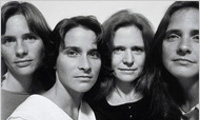 Feasting on Memories, Serving the Future
Feasting on Memories, Serving the FutureBy CHLOE VELTMAN
Published: February 19, 2010
Perhaps more than any other work on display at the San Francisco Museum of Modern Art, “The Brown Sisters” by Nicholas Nixon captures the essence of the institution’s 75th anniversary celebration. The work is a set of 35 photographic portraits, made annually since 1975, of the artist’s wife and her three siblings standing in the same order. The museum acquired the artwork in 2000, and, as of now, there is no official end date to this act of creation.
Jeff Koons’s “Michael Jackson and Bubbles” is part of the San Francisco Museum of Modern Art’s anniversary show.
Just as the past and future fuse in Mr. Nixon’s photographs, so the San Francisco Museum of Modern Art, founded in 1935 as the San Francisco Museum of Art, is taking a Janus-like approach to its milestone year.
Arts organizations often use anniversaries as an excuse for self-flattery and financial opportunism. The recent 30th anniversary celebration for the Museum of Contemporary Art in Los Angeles — with its ritzy gala headlined by Lady Gaga and the Bolshoi Ballet and a no-holds-barred campaign to raise $60 million — threatened to eclipse the opening of the museum’s important anniversary show, one of the largest exhibitions in its history.
Closer to home, the San Francisco Mime Troupe’s 50th birthday last year focused more on its glorious past than its uncertain future. But SF MoMA has managed to keep in balance the elements necessary to celebrate a major milestone, including innovative programming, fund-raising and outreach.
With new multimedia tours, inventive collaborations with local and international artists and, most significantly, ambitious new expansion plans, the museum is intent on looking ahead. Two weeks ago, officials said they had raised $250 million in just six months, letting the museum double its endowment and put $150 million toward the building of a new wing and other development. These plans emphasize that this institution, unlike others that have been around for a while, is as proud of its present and future as it is of its innovative past.
To be sure, the yearlong celebration, a series of shows and events, offers plenty of backward looks. The freewheeling core exhibition, “The Anniversary Show,” which runs through Jan. 16, 2011, features more than 400 works from the museum’s permanent collection. And “Focus on Artists,” which runs through May 23, explores the museum’s past relationship with 18 influential artists, including Richard Serra, Diane Arbus and Andy Warhol.
Still, the historical “Anniversary Show” doesn’t come across as the typical self-aggrandizing archival survey. The museum may have been the first art institution to give a then-unknown Jackson Pollock his first solo museum show, in 1945, but the exhibition, which features his “Guardians of the Secret” (1943) among others, doesn’t play up such accolades.
At first glance, the second floor appears to resemble the schizophrenic found-object collages of local Mission School artists like Barry McGee (whose “Untitled,” an undulating montage of hundreds of framed drawings and photographs, is on display). Works by such well-known artists as Pollock, Alexander Calder, and Arshile Gorky share space with a selection of 1950s bright watercolors by teenage artists from Southern Rhodesia (now Zimbabwe). Galleries devoted to the museum’s collection of antique Olivetti typewriters and archival footage of its television programs from the early 1950s contrast glaringly with Jeff Koons’s glossy ceramic sculpture “Michael Jackson and Bubbles” and Penelope Umbrico’s “5,377,183 Suns From Flickr (Partial) 4/28/09,” which consists of snapshots of sunsets culled from the Flickr image-sharing Web site.
Yet for all its eclecticism, the exhibition proffers an interesting, if slightly obscure, curatorial logic, inspired by the museum’s founding director, Grace McCann Morley. By highlighting Morley’s curatorial interests and borrowing her aesthetic, the show provides fascinating insight into the life of this formidable but little-remembered West Coast art trailblazer.
Morley, who died in 1985 at the age of 85, was the sort of curator who responded to the horrors of war by presenting works that engaged directly with the theme of conflict, like Picasso’s “Guernica,” as well as by shows that served as a lighthearted distraction, like the museum’s 1942 exhibition, “Sawdust and Spangles: Arts of the Circus.” With her broad-minded legacy in mind, the seemingly wacky curatorial approach behind “The Anniversary Show” makes more sense.
That eclecticism extends to the museum’s overall engagement with the here and now. It places a welcome emphasis on local culture by commissioning Bay Area artists from a wide variety of fields to engage with works in its collection. For example, a new audio tour features the San Francisco electronica duo, Loop!Station, responding to James Rosenquist’s “Leaky Ride for Dr. Leakey” (1983) with a song that is as bold and angular as Mr. Rosenquist’s Pop Art painting. Similarly, the museum’s “Muse” advertising campaign pairs local cultural luminaries like the couturier Colleen Quen and the author Robert Mailer Anderson with well-known works from the museum’s collection.
As the San Francisco Museum of Modern Art’s current efforts show, anniversaries can have a galvanizing effect on an institution and its community. But they must be approached with caution. These celebrations should do more than dwell on the past; they should take stock of the present. And to have something to celebrate 25, 50 or 75 years from now, they should always keep an eye on the future.
Information on the San Francisco Museum of Modern Art’s anniversary exhibitions and events: (415) 357-4000 or sfmoma.org.
 Feasting on Memories, Serving the Future
Feasting on Memories, Serving the Future